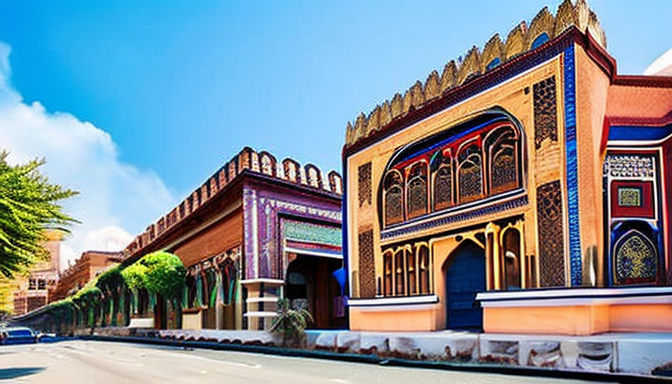Karachi, a city that never sleeps, is often known for its bustling streets and vibrant culture. But have you ever paused to look up? The hidden architectural treasures of this metropolis tell tales of history, culture, and artistry that are just waiting to be discovered. From the intricate designs of historic buildings to the serene beauty of mosques, each structure has a story to share.
Take a stroll through the streets of Saddar, and you’ll find the stunning Frere Hall. Built in the 19th century, this building is a beautiful blend of Gothic and Venetian styles. It stands as a reminder of British colonial influence while also being a part of the local community. Did you know it was originally constructed as a town hall? Today, it serves as a cultural hub, hosting art exhibitions and community events.
Then there’s the Mohatta Palace, a magnificent structure that whispers tales of the past. With its pink stone and intricate carvings, this palace was built for a wealthy merchant. Now, it’s a museum showcasing the rich heritage of Karachi. Each corner of the palace invites you to explore its history, making it a must-visit for anyone interested in architecture.
And let’s not forget the stunning mosques that dot the city. The Shah Jahan Mosque in Thatta, though a bit outside Karachi, is worth mentioning. Its exquisite tile work and grand arches are a testament to Mughal architecture. These mosques not only serve as places of worship but also as architectural masterpieces that reflect the city’s spiritual and cultural identity.
So, next time you’re in Karachi, remember to look beyond the hustle and bustle. The city’s architectural gems are waiting to tell you their stories. They are not just buildings; they are a celebration of Karachi’s rich history and diverse cultures.
Historical Significance of Karachi’s Architecture
Karachi is a city that tells stories through its buildings. Each structure is like a page in a book, revealing the rich tapestry of its past. From the bustling streets to the serene corners, Karachi’s architecture reflects the influences of various cultures and eras. When you stroll through the city, you can almost hear the whispers of history. Historic buildings, mosques, and monuments stand as testaments to the city’s evolution.
Take the iconic Frere Hall, for instance. Built in the late 19th century, it showcases a blend of Gothic and Renaissance styles. This structure was not just a library; it was a hub for the community. It reminds us of a time when Karachi was a small trading port, bustling with life and opportunity. Then there’s the Mohatta Palace, a stunning example of Indo-Saracenic architecture. With its intricate stonework and vibrant colors, it tells the story of the affluent merchant class that once thrived here.
Moreover, the Masjid-e-Tooba, also known as the Tooba Mosque, is a marvel in its own right. With its massive dome, it stands as a symbol of unity and peace. Each of these structures is a piece of the puzzle that forms Karachi’s unique architectural identity. They remind us that architecture is not just about buildings; it’s about the people and stories behind them.
In essence, Karachi’s architecture is a living history. It invites us to explore, understand, and appreciate the diverse influences that have shaped this vibrant city over time.

Unique Architectural Styles Found in Karachi
Karachi is like a vibrant tapestry, woven with threads of different cultures and histories. When you stroll through its streets, you can’t help but notice the unique architectural styles that tell stories of the past. Each building is a chapter, revealing influences from various eras and communities. For instance, the stunning Mohatta Palace stands as a testament to the Indo-Saracenic style, blending Islamic and Gothic elements. It’s not just a palace; it’s a piece of art that whispers tales of the British Raj.
Then there are the beautiful mosques, like the iconic Frere Hall. This structure boasts a mix of Victorian and Islamic architecture, showcasing Karachi’s colonial past while honoring its rich Islamic heritage. The intricate tile work and soaring minarets are not just for show; they reflect the city’s spiritual heartbeat.
Let’s not forget the art deco buildings that line the streets, echoing the style popular in the 1920s and 30s. These structures, with their clean lines and geometric shapes, add a modern flair to the city’s historical landscape. They remind us that Karachi is not just about the past but also about embracing the future.
In essence, Karachi’s architecture is a melting pot of influences. From colonial-era buildings to modern designs, each style contributes to the city’s distinctive character. It’s a place where every corner turned reveals a new story, waiting to be discovered.
Frequently Asked Questions
- What are some hidden architectural gems in Karachi?
Karachi is home to numerous hidden treasures, including the stunning Frere Hall, the elegant Mohatta Palace, and the unique KMC Building. Each of these sites boasts a rich history and showcases distinctive architectural styles that reflect the city’s diverse cultural heritage.
- Why is the architectural heritage of Karachi important?
The architectural heritage of Karachi serves as a testament to the city’s evolution over time. It tells the stories of different cultures and influences that have shaped the city, making it a vibrant tapestry of history and design. Preserving these buildings is crucial for maintaining the city’s identity.
- How can I explore Karachi’s architectural sites?
You can explore Karachi’s architectural sites through guided tours, local heritage walks, or even by visiting them on your own. Many of these sites are accessible to the public, allowing you to immerse yourself in the beauty and history of Karachi’s unique architecture.
- Are there any events related to architecture in Karachi?
Yes! Karachi hosts various events, including architecture festivals, exhibitions, and workshops that focus on preserving and promoting the city’s architectural heritage. Keeping an eye on local cultural calendars can help you find these exciting opportunities!